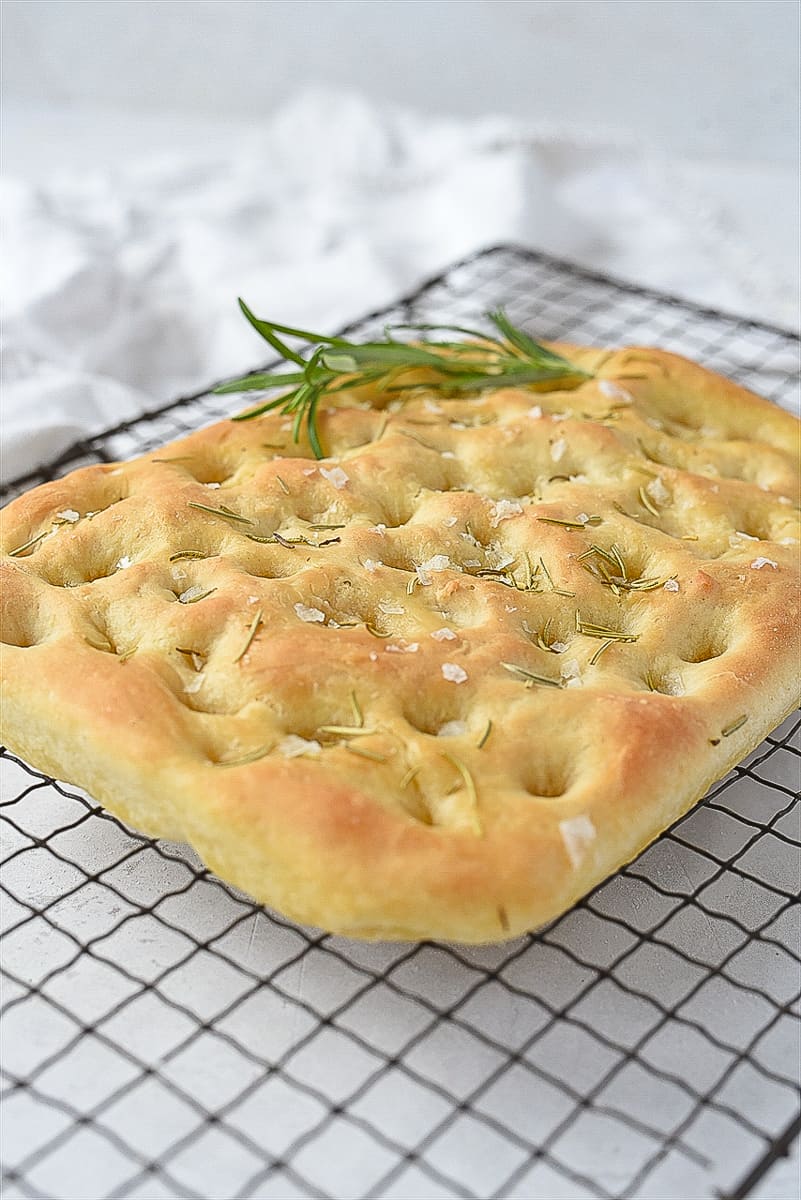Homemade French Croissants (Small Batch)
Your folders
Your folders
Prep Time: 70 minutes
Cook Time: 25 minutes
Total: 455 minutes
Servings: 6
Author : Dini @ The Flavor Bender

Ingredients
Export 7 ingredients for grocery delivery
Instructions
Step 1
Dissolve the honey in the milk in a mixing bowl, and then whisk in the yeast. Set aside for the yeast to activate for about 10 - 20 minutes.
Step 2
Add the rest of the ingredients into the bowl in the order listed in the ingredients list. Stir with a spatula or spoon to mix it into a scraggly dough.
Step 3
Using your hand, knead the dough for about 1 - 2 minutes until a scraggly dough is formed.
Step 4
Take the dough out of the bowl and knead it on a work surface until smooth - about 4 minutes. You shouldn’t have to put too much effort into kneading here because it isn’t a very stiff dough. Place the dough back in the mixing bowl and cover with plastic wrap.
Step 5
Keep the bowl in a warm place, and proof until at least doubled in size (this can take about 1 hour).
Step 6
After the first proof, turn the dough out onto a lightly floured surface and flatten it to knock out the air. Transfer the dough onto the first parchment paper and shape it into a rectangle. Fold the other half of the parchment paper over the dough, forming a 7 x 10 inch case. Use a rolling pin to roll out the dough to fit the 7 x 10 inch square. (It doesn’t have to fill the 7 x 10 inch square perfectly, just as closely as possible).
Step 7
Cover the parchment paper encased dough well in plastic wrap, and place it in a quarter sheet pan. Freeze for at least a few hours, or overnight.
Step 8
Slice the cold butter into thin slices.
Step 9
Arrange them on the 1st parchment paper, within the 5 x 6.5 inch marked rectangle (see picture in the post). Fold the parchment paper over to enclose the butter.
Step 10
Using a rolling pin, firmly hit the butter to make it more pliable. Then, using the rolling pin, roll out/spread the butter inside the parchment paper.
Step 11
Make sure to roll the butter out into the corners, but also keep the butter evenly thick.
Step 12
Transfer this butter block into the fridge until completely hardened (or overnight).
Step 13
IMPORTANT - when laminating the butter and dough, it’s REALLY crucial that they both have similar pliability and are cold. If my dough is frozen solid, I keep it at room temp. for about 30 minutes to let it soften slightly, before starting the lamination process.
Step 14
The butter block is removed from the fridge just before lamination, but made pliable by knocking a rolling pin against it repeatedly. It should remain cold.
Step 15
Remove the parchment paper from the dough and place it on an un-floured (or very lightly floured) work surface. If it’s not quite a 7 x 10 inch rectangle, roll it out to the correct size, making sure it’s still evenly thick.
Step 16
Unwrap the parchment paper from the butter block, but keep the butter still attached to the parchment paper.
Step 17
Place the butter block on one half of the dough. There should be a very small border around the butter block and it should still have the parchment paper on top. Once the butter is correctly in place, pat it onto the dough to let it “bind” to the dough. Carefully peel off the parchment paper.
Step 18
Fold the dough over the butter, end to end, completely enclosing the butter. Press the edges to seal the butter inside the dough. Pat the dough again to help the butter “bind” to the dough.
Step 19
The dough should still be very cold. If it isn’t, wrap it and put it back in the fridge for about 30 minutes.
Step 20
Generously flour your work surface and dough. Place the dough on the work surface and using the rolling pin, gently press, along the length of the dough, to make sure the butter is pliable.
Step 21
While maintaining the 5 inch (12.7 cm) width (short end), roll out the dough to a length of approximately 16 inches (40 cm).
Step 22
Use flour as needed to make sure the dough doesn’t stick to the counter, and use your hands to keep the width even and straight. (You can also gently lift the dough as you roll to make sure it isn’t sticking to the countertop).
Step 23
Work quickly to keep the dough and butter cold. If the butter softens too much, return the dough to the fridge or freezer.
Step 24
Brush off excess flour on the work surface using a large pastry brush. Trim just a little piece of dough along the edges, to make the width straight.
Step 25
Fold in about 1/8th of the dough towards the middle (about 2 - 3 inches). Bring the other end to meet the folded end. Make sure the two ends are as close together as possible with no gaps. Using a paring knife, make small cuts at the four corners of the folds to release the tension (4 cuts; please see pictures in the post).
Step 26
Brush off excess flour on the surface of the dough. Now, fold the dough in half. Firmly tap the dough to keep the shape. Again, make cuts at the corners of the fold (2 cuts).
Step 27
Wrap the dough with plastic wrap and refrigerate for at least 30 minutes (60 minutes is even better).
Step 28
Generously flour the work surface and place the dough on it. Gently press into the dough with a rolling pin along the length of it to make sure the butter inside is pliable.
Step 29
Keeping the short end as the width (4 inches / 10 cm), roll out the dough to 15 inches (38 cm). As you roll out the dough, make sure the final width is kept to about 5 inches. Also make sure the dough isn’t sticking to the work surface, and the width is straight and even.
Step 30
Brush off excess flour from the surface of the dough using a pastry brush.
Step 31
Fold in ⅓ of the dough towards the center (about 5 inches / 12.7 cm). As before, cut the corners of the fold with a paring knife to release tension.
Step 32
Brush off excess flour again, and fold the other edge of the dough OVER the first fold. Cut the folded corners with a paring knife to release tension.
Step 33
Wrap the dough in plastic wrap and refrigerate for another 30 minutes (preferably 60 minutes).
Step 34
Place the dough on a well-floured surface - the edge where you can see all the folds should be facing you.
Step 35
Gently press the dough with a rolling pin along the length of it to make the dough and butter pliable.
Step 36
Roll out the dough to about a 1 cm thickness (with an 8 - 9 inch width at the edge facing you).
Step 37
Wrap the dough and refrigerate for about 30 - 45 minutes to allow the gluten to rest.
Step 38
Roll out the rested dough to about a 4 - 5 mm thickness. Use flour to make sure the dough doesn’t stick to the surface.
Step 39
I like to keep a width of about 9.5 - 10 inches (23 - 24 cm) and roll it out to a 4 - 5 mm thickness. Again, make sure the dough isn’t sticking to the work surface BEFORE you starting cutting the dough in the next step.
Step 40
If, at any point, the dough becomes too soft or starts to shrink, wrap it and return it to the fridge for at least 30 minutes.
Step 41
Cut a very thin strip along the long edges of the dough to have a width of 9 inches / 23 cm. Make sure the edges are straight and even. Use a pizza cutter or a sharp knife. Avoid dragging the knife along the dough as you cut it, as this can distort the dough. Simply press the knife or pizza cutter straight down to cut.
Step 42
Along one of the long edges, make 3.5 inch / 9 cm markings. Then make 9 cm markings on the opposite edge as well, BUT these markings will be halfway between the markings along the first edge.
Step 43
Use the ruler and a small sharp knife to connect the markings on the two sides with straight lines.
Step 44
Using the marked lines as a guide, cut the dough with a pizza cutter or a sharp, long knife. You should end up with about 6 triangles, and a leftover piece.
Step 45
Brush off excess flour from both sides of the dough triangle and keep it on the work surface.
Step 46
Make a 1 cm cut at the mid point along the base of the triangle. Roll up the base, while gently pulling at the two corners to make the base slightly wider. (The cut that was made along the middle of the base helps with this.)
Step 47
Once you have rolled up the base once, then you can roll up the croissant the rest of the way more easily. Make sure the tip of the triangle is properly centered the whole way.
Step 48
Also make sure not to roll out the croissant too tightly or too loosely.
Step 49
Place the rolled up croissant dough on the lined half sheet baking pan (6 on a tray), while making sure the tip of the croissant triangle is placed under the croissant. Gently press on the croissant to seal the tip at the bottom into the dough (take care not to squash the croissant!).
Step 50
Cover with plastic wrap, and another half sheet pan on top. Make sure there's plenty of space within the baking pans so that proofed croissants don’t stick to the half sheet pan on top.
Step 51
Proof the croissants (somewhere that is about 25°C / 77°F) until doubled in size. The time can vary depending on the weather. I proof mine inside an oven with just the light turned on, and it still takes me between 2 - 3 hours.
Step 52
The croissants have proofed if they have doubled in size, look very pillowy, and will jiggle a little when you give the sheet pan a shake.
Step 53
Preheat the oven to 375°F /190°C, at least 30 minutes before baking the croissants.
Step 54
Brush with an egg wash (use a soft, small pastry brush, because the croissants are very delicate at this stage). Bake at 375°F / 190°C (conventional oven) for about 20 minutes until golden brown. Turn the tray once halfway through the baking time, if needed.
Step 55
Remove from the oven and let them cool for a few minutes before transferring the croissants onto a cooling wire rack. Then let them cool down further to allow the insides to set (otherwise the croissants will be too soft).
Top similar recipes
Curated for youYour folders
 88 views
88 viewsHomemade French Croissants (small b...
theflavorbender.com
Your folders

 352 views
352 viewsSmall Batch Homemade Tahini
afamilyfeast.com
5 minutes
Your folders

 233 views
233 viewsHomemade Croissants (French recipe)
lacuisinedegeraldine.fr
4.9
(113)
Your folders

 371 views
371 viewsSmall Batch Applesauce
cookfasteatwell.com
5.0
(4)
20 minutes
Your folders

 556 views
556 viewssmall-batch eggnog
smittenkitchen.com
Your folders

 282 views
282 viewsSmall Batch Brownies
thecookiedoughdiaries.com
5.0
(76)
Your folders

 253 views
253 viewsSmall-Batch Brownies
dessertfortwo.com
4.5
(221)
23 minutes
Your folders

 569 views
569 viewsSmall Batch Pralines
onedishkitchen.com
5.0
(1)
15 minutes
Your folders

 490 views
490 viewsSmall Batch Brownies
cookingclassy.com
4.9
(32)
20 minutes
Your folders

 244 views
244 viewsSmall Batch Granola
frommybowl.com
5.0
(5)
18 minutes
Your folders

 311 views
311 viewsSmall Batch Cornbread
easyhealthllc.com
4.7
(33)
20 minutes
Your folders

 340 views
340 viewsSmall-Batch Macarons
dessertfortwo.com
4.4
(207)
13 minutes
Your folders

 407 views
407 viewsSmall Batch Pusharatas
deepsouthdish.com
30 minutes
Your folders

 299 views
299 viewsSmall Batch Eggnog
blossomtostem.net
4.6
(19)
2 minutes
Your folders

 633 views
633 viewsSmall Batch Focaccia
yourhomebasedmom.com
4.9
(31)
15 minutes
Your folders
 96 views
96 viewsSmall Batch Focaccia
yourhomebasedmom.com
Your folders

 333 views
333 viewsEasy Homemade Curry Powder (Small B...
curiouscuisiniere.com
4.6
(34)
Your folders

 525 views
525 viewsHomemade Croissants
jocooks.com
4.5
(502)
24 minutes
Your folders

 653 views
653 viewsHomemade Croissants
jocooks.com
4.5
(570)
24 minutes